Hēni Jacob has shared her thoughts the translation of kids books into te reo Māori, specifically the second Diary of a Wimpy Kid book: Rodrick Rules.
Note that any purchases made from the link provided will not be dispatched until after the Covid-19 Alert Level decreases to a level where Aotearoa’s bookshops are operational again.
Ka taea e koutou tēnei kōrero i te reo Māori.
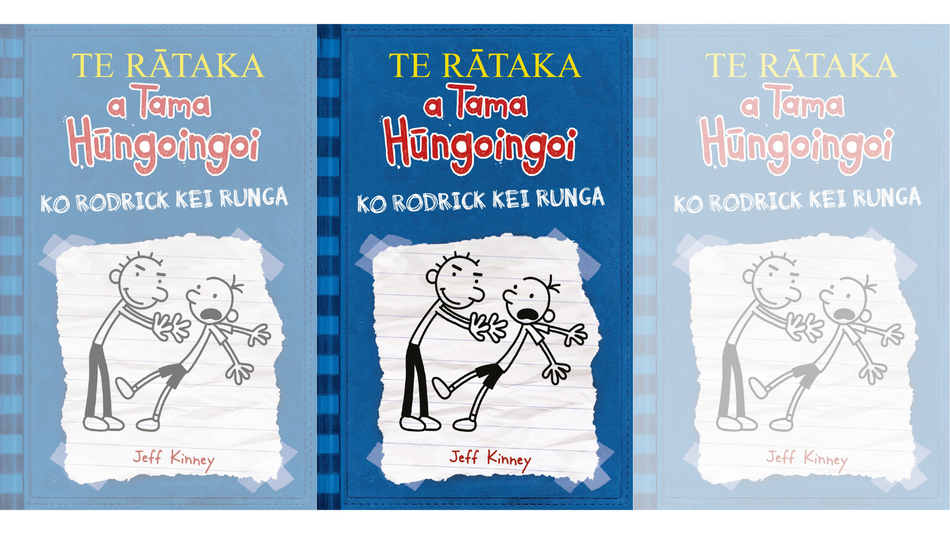
Translating the first two books in the Diary of a Wimpy Kid series was great fun, though not without its challenges.
One challenge in the Diary of a Wimpy Kid books is that they are brimming with onomatopoeic words and exclamations, as you’d expect in a ‘novel in cartoons’. The first page in Rodrick Rules, where Rodrick is playing the drums, says it all: CRASH SMASH BADUM THUMP WHOMP BIDI BUM BOP. My translation mostly used established Māori words with similar sounds and meanings, for example, KURU for SMASH and HAPURU for THUMP, though a few I made up to mirror the sounds I felt the English was trying to capture, for example PIRI PĀ PAKO for BIDI BUM BOP.
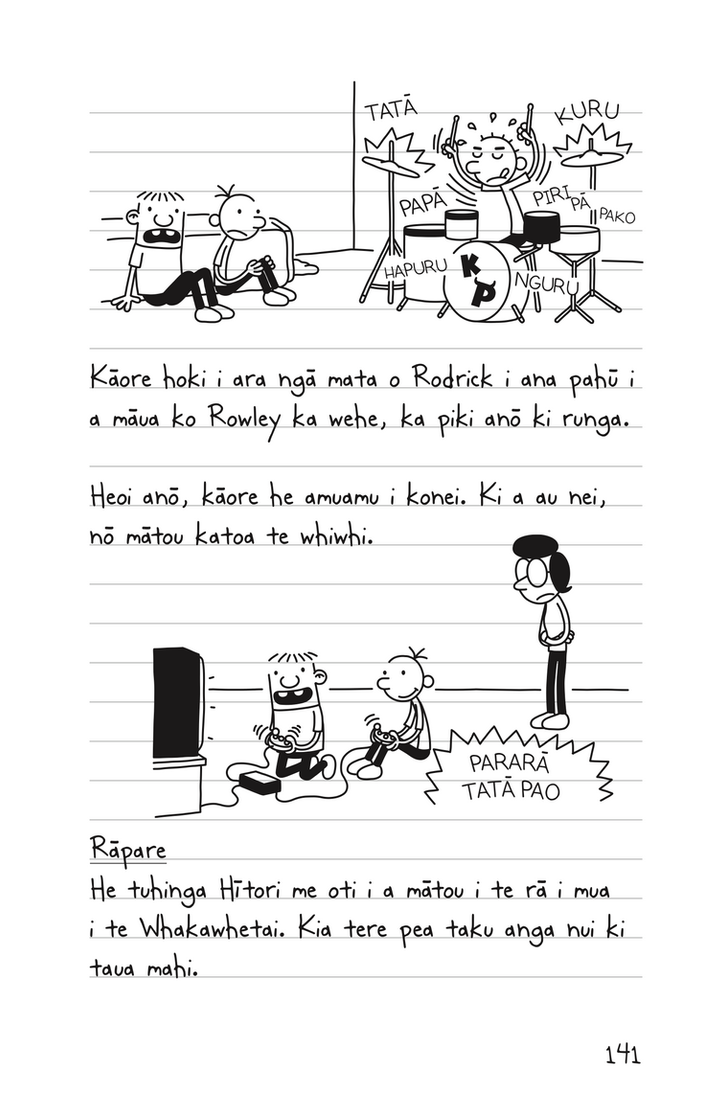
Fortunately, most of the exclamations used in the books have Māori equivalents. Examples include Gaah! (in context, meaning something like ‘Damn!’, for which I used Aeha!), ‘Whatever!’ (Kia ahatia!) and ‘Dag Nab’ (Pōkokohua). Not all of the Māori exclamations featured in the book are well-known, but the intended meaning of most can be worked out from the context and the looks on the faces of the participants. In this way the Wimpy Kid books serve as a great vehicle for teaching these economical and lively Māori expressions.
Not all of the Māori exclamations featured in the book are well-known, but the intended meaning of most can be worked out from the context and the looks on the faces of the participants.
Where the source of humour involved some language play – a pun, a silly poem, or humourous pronunciation, I often had to find something with equivalence, as the exact same play on meaning or pronunciation didn’t work in the Māori. For example, in the second book, the neighbours think it’s cute that Greg’s little brother has trouble pronouncing the word ‘chocolate’, saying ‘chokwit’ instead. The word used for ‘chocolate’ in the Māori version is ‘tiakarete’. A more authentic example of how very young speakers of Māori sometimes struggle to pronounce that word is ‘takalete’, where the ’i’ is omitted and the rolled ‘r’ is pronounced instead as an ‘l’, so this is what I used instead here.
Rodrick is Greg’s older brother (and the bane of his life). He is in a band called Loded Diper, which is written on the side of the band’s van. The name is either a play on, or misspelling of, ‘loaded diaper’, depending on how you rate Rodrick’s ability to write and spell. Greg, however, is pretty sure the interesting spelling is by accident rather than design.
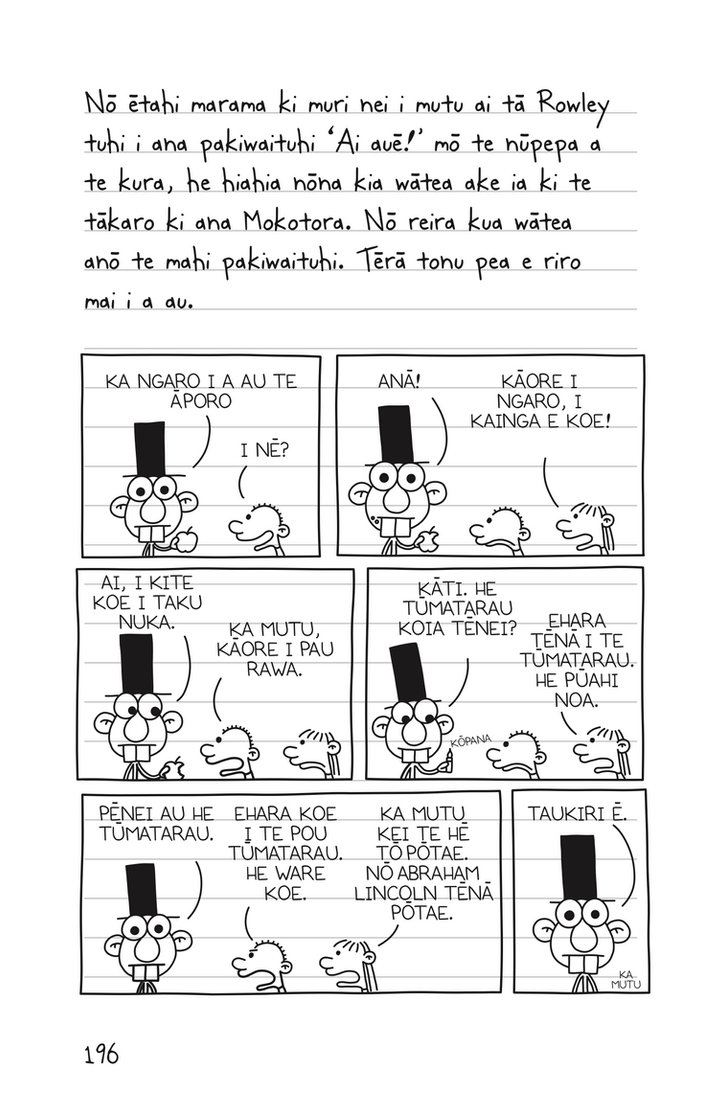
The dilemma in the Māori is that all words pronounced the same are also written identically – this ruled out that particular way of making the name of Rodrick’s band humourous. I opted instead to retain the sense of a ‘full diaper’ (or nappy, as we call them in New Zealand), as that is where the humour lies. I used ‘kope kī’, but to mask that slightly, as the English representation does, and to convey the idea that Rodrick’s writing skills mightn’t be that flash, I split the words in the wrong place to produce Ko Pekī. Hopefully there’s a good chance a Māori speaker will still smirk when reading this.
Hopefully there’s a good chance a Māori speaker will still smirk when reading this.
A challenge that I often encounter when translating from English to Māori is trying to make the equivalent Māori wording fit into the same space as the English does. This job was no different. The language of the Wimpy Kid books, whilst not particularly difficult, doesn’t have a great deal of built-in redundancy, making it hard to pare down the Māori without leaving something important out.
Even just the length of a keyword can cause problems. With ‘magic act’, for example, I felt ‘mahi tūmatarau’ was the best translation; the Māori wording, however, is five characters longer. A trifling matter, you might think, but if it occurs twice on the one page, as keywords sometimes do, it could contribute to an overrun. Where this happened, I had to find ways to shorten the translation, as the cartoons and the associated text obviously couldn’t appear on different pages.
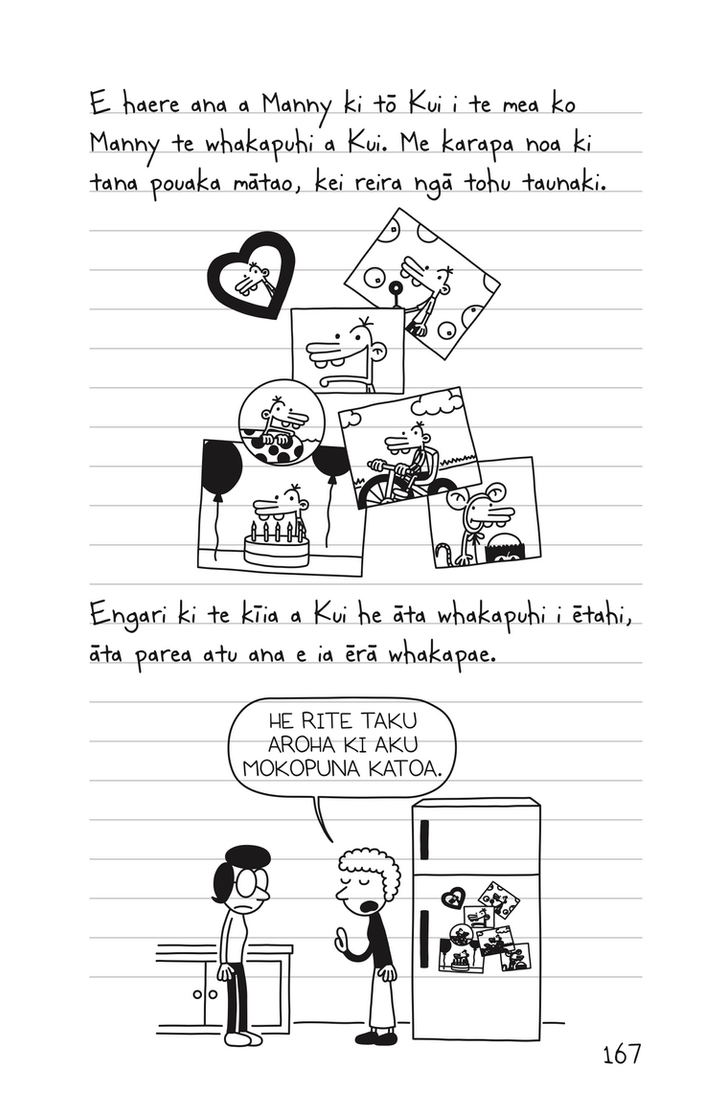
Both books I worked on contained little ditties and poems. These too couldn’t be translated word for word in a way that retained the humour. Instead, I had to fashion something that was similar in terms of content and length, rhyme (where appropriate), and of course humour – not the easiest of tasks!
I had to fashion something that was similar in terms of content and length, rhyme, and of course humour – not the easiest of tasks!
I found myself googling a number of Americanisms to ensure I knew what they meant. ‘Dag nab’ was one. From the context, I was fairly sure it was similar to ‘Damn’, but thought it prudent to double-check. I was terribly thankful too that I took the time to ponder the intended meaning of ‘big fanny granny’ I encountered in the first book. Initially I was startled that this had gone through unchallenged and unchanged in a book written for 12 year old boys (or for anyone for that matter). I then recalled an occasion a year or two ago when someone had explained to me that a ‘fanny pack’ is what we used to call a ‘bum bag’ in my day. I was much relieved when I realised this, and that I’d stopped short of creating possibly the worst and most embarrassing mistranslation from English to Māori of all time!
Translating may be fun, but it’s not child’s play.
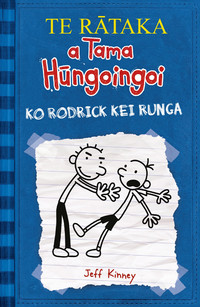
Te Rātaka a Tama Hūngoingoi: Ko Rodrick Kei Runga
By Jeff Kinney
Translated by Hēni Jacob
Penguin NZ
RRP: $22.00
Hēni Jacob
Hēni Jacob is from Ngāti Raukawa and lives in Ōtaki. Alongside English to Māori translation work of all types, she also writes her own Māori language resources and books for medium to advanced learners of the language.



